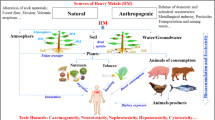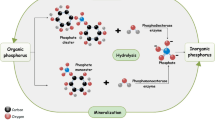Abstract
The capacity of an anaerobic sediment to achieve the simultaneous biodegradation of phenol and carbon tetrachloride (CT) was evaluated, using humic acids (HA) as redox mediator. The presence of HA in sediment incubations increased the rate of biodegradation of phenol and the rate of dehalogenation (2.5-fold) of CT compared to controls lacking HA. Further experiments revealed that the electron-accepting capacity of HA derived from different organic-rich environments was not associated with their reducing capacity to achieve CT dechlorination. The collected kinetic data suggest that the reduction of CT by reduced HA was the rate-limiting step during the simultaneous biodegradation of phenol and CT. To our knowledge, the present study constitutes the first demonstration of the simultaneous biodegradation of two priority pollutants mediated by HA.




Similar content being viewed by others
Abbreviations
- HA:
-
Humic acids
- ETC:
-
Electron-transferring capacity
- TEA:
-
Terminal electron acceptor
- RM:
-
Redox mediators
- AQDS:
-
Anthraquinone-2,6-disulfonate
- CT:
-
Carbon tetrachloride
- CS:
-
Anaerobic sludge from a factory of candies
- PS:
-
Anaerobic sludge from a paper-mill factory
- S:
-
Sediment
- VS:
-
Volatile solids
- VFA:
-
Volatile fatty acids
- AH2QDS:
-
Anthrahydroquinone-2,6-disulfonate
- R 2 :
-
Coefficient of determination
- SCP:
-
Soil of cocoa plantation
- SDF:
-
Soil of deciduous forest in San Luis Potosí, Mexico
- GWC:
-
Compost produced with gardening wastes
- IHSS:
-
International Humic Substance Society
- EAC:
-
Electron accepting capacity
- μEq:
-
Micro-electron equivalents
- CF:
-
Chloroform
- DCM:
-
Dichloromethane
- k d2 :
-
Second-order rate constant
- k d1 :
-
First-order rate constant
References
Aranda-Tamaura C, Estrada-Alvarado MI, Texier AC, Cuervo F, Gómez J, Cervantes FJ (2007) Effects of different quinoid redox mediators on the removal of sulphide and nitrate via denitrification. Chemosphere 69:1722–1727
Benz M, Schink B, Brune A (1998) Humic acid reduction by Propionibacterium freudenreichii and other fermentative bacteria. Appl Environ Microbiol 64:4507–4512
Bradley PM, Chapelle FH, Lovley DR (1998) Humic acids as electron acceptors for anaerobic microbiol oxidation of vinyl chloride and dichloethene. Appl Environ Microbiol 64:3102–3105
Bruce RA, Achenbach LA, Coates JD (1999) Reduction of (per)chlorate by a novel organism isolated from paper mill waste. Environ Microbiol 1:319–329
Cervantes FJ, van der Velde S, Lettinga G, Field JA (2000) Quinones as terminal electron acceptors for anaerobic microbial oxidation of phenol compounds. Biodegradation 11:313–321
Cervantes FJ, Dijksma W, Duong-Dac T, Ivanova A, Lettinga G, Field JA (2001a) Anaerobic mineralization of toluene by enriched sediments with quinones and humus as terminal electron acceptors. Appl Environ Microbiol 67:4471–4478
Cervantes FJ, van der Zee FP, Lettinga G, Field JA (2001b) Enhanced decolourisation of acid orange 7 in a continuous UASB reactor with quinones as redox mediators. Water Sci Technol 44:123–128
Cervantes FJ, Vu-Thi-Thu L, Lettinga G, Field JA (2004) Quinone-respiration improves dechlorination of carbon tetrachloride by anaerobic sludge. Appl Microbiol Biotechnol 64:702–711
Cervantes FJ, Gutiérrez CH, López KY, Estrada-Alvarado MI, Meza-Escalante ER, Texier AC, Cuervo F, Gómez J (2008) Contribution of quinone-reducing microorganisms to the anaerobic biodegradation of organic compounds under different redox conditions. Biodegradation 19:235–246
Coates JD, Cole KA, Chakraborty R, O’Connor SM, Achenbach LA (2002) Diversity and ubiquity of bacteria capable of utilizing humic substances as electron donors for anaerobic respiration. Appl Microbiol Biotechnol 68:2445–2452
Curtis GP, Reinhard M (1994) Reductive dehalogenation of hexachloroethane, carbon tetrachloride and bromoform by anthrahydroquinone disulfonate and húmica acid. Environ Sci Technol 28:2393–2401
Doong R-A, Chiang H-C (2005) Transformation of carbon tetrachloride by thiol reductants in the presence of quinone compound. Environ Sci Technol 39:7460–7468
Field JA, Cervantes FJ, van der Zee FP, Lettinga G (2000) Role of quinones in the biodegradation of priority pollutans: a review. Water Sci Technol 42:215–222
Guerrero-Barajas C, Field JA (2005) Riboflavin and cobalamin mediated biodegradation of chloroform in a methanogenic consortium. Biotechnol Bioeng 89:539–550
Jiang J, Kappler A (2008) Kinetics of microbial and chemical reduction of humic substances: implications for electron shuttling. Environ Sci Technol 42:3563–3569
Kappler A, Haderlein SB (2003) Natural organic matter as reductant for chlorinated aliphatic pollutants. Environ Sci Technol 37:2714–2719
León-García GJ, Razo-Flores E, Cervantes FJ (2007) Propiedades catalíticas del humus y su potencial aplicación en la degradación de contaminantes prioritarios. Revista Latinoamericana de Recursos Naturales 3(2):118–128
Li XM, Zhou SG, Li FB, Wu CY, Zhuang L, Xu W, Liu L (2009) Fe(III) oxide reduction and carbon tetrachloride by a newly isolated Klebsiella pneumoniae strain L17. J Appl Microbiol 106:130–139
Liu G, Zhou J, Wang J, Zhou M, Lu H, Jin R (2009) Acceleration of azo dye decolorization by using quinone reductase activity of azoreductase and quinone redox mediator. Biores Technol 100:2791–2795
Lovley DR, Coates JD, Blunt-Harris EL, Phillips EJP, Woodward JC (1996) Humic substances as electron acceptors for microbial respiration. Nature 382:445–448
Lovley DR, Fraga JL, Coates JD, Blunt-Harris EL (1999) Humics as an electron donor for anaerobic respiration. Environ Microbiol 1:89–98
Minderlein S, Blodau C (2010) Humic-rich peat extracts inhibit sulfate reduction, methanogenesis, and anaerobic respiration but not acetogenesis in peat soils of a temperate bog. Soil Biol Biochem 42(12):2078–2086
Perminova IV, Kovalenko AN, Schmitt-Kopplin P, Hatfield K, Hertkorn N, Belyaeva EY, Petrosyan VS (2005) Desing of quinonoid-enriched humic materials with enhanced redox properties. Environ Sci Technol 39:8518–8524
Ratasuk N, Nanny MA (2007) Characterization and quantification of reversible redox sites in humic substances. Environ Sci Technol 41:7844–7850
Rau J, Knackmuss H-J, Stolz A (2002) Effects of different quinoid redox mediator on the anaerobic reduction of azo dyes by bacteria. Environ Sci Technol 36:1497–1504
Stevenson FJ (1994) Humus chemistry: genesis, composition reactions. Wiley, New York
Van der Zee FP, Cervantes FJ (2009) Impact and application of electron shuttles on the redox (bio)transformation of contaminants: a review. Biotechnol Adv 27:256–277
Watanabe K, Manefield M, Lee M, Kouzuma A (2009) Electron shuttles in biotechnology. Curr Opin Biotechnol 20:1–9
Acknowledgments
The present study was financially supported by the Council of Science and Technology of Mexico (SEP-CONACYT Grants 55045 and 155656) and by the Lettinga Associates Foundation (Lettinga Award 2007). C. M. Martínez-Rodríguez is grateful for the scholarship for PhD studies from CONACyT (Grant 206474). We acknowledge the use of facilities of the National Laboratory of Agricultural, Medical and Environmental Biotechnology (LANBAMA). We thank the technical assistance of M.C. Rocha-Medina, G. Vidriales-Escobar and D. Partida-Gutiérrez.
Author information
Authors and Affiliations
Corresponding author
Rights and permissions
About this article
Cite this article
Martínez, C.M., Alvarez, L.H. & Cervantes, F.J. Simultaneous biodegradation of phenol and carbon tetrachloride mediated by humic acids. Biodegradation 23, 635–644 (2012). https://doi.org/10.1007/s10532-012-9539-8
Received:
Accepted:
Published:
Issue Date:
DOI: https://doi.org/10.1007/s10532-012-9539-8




